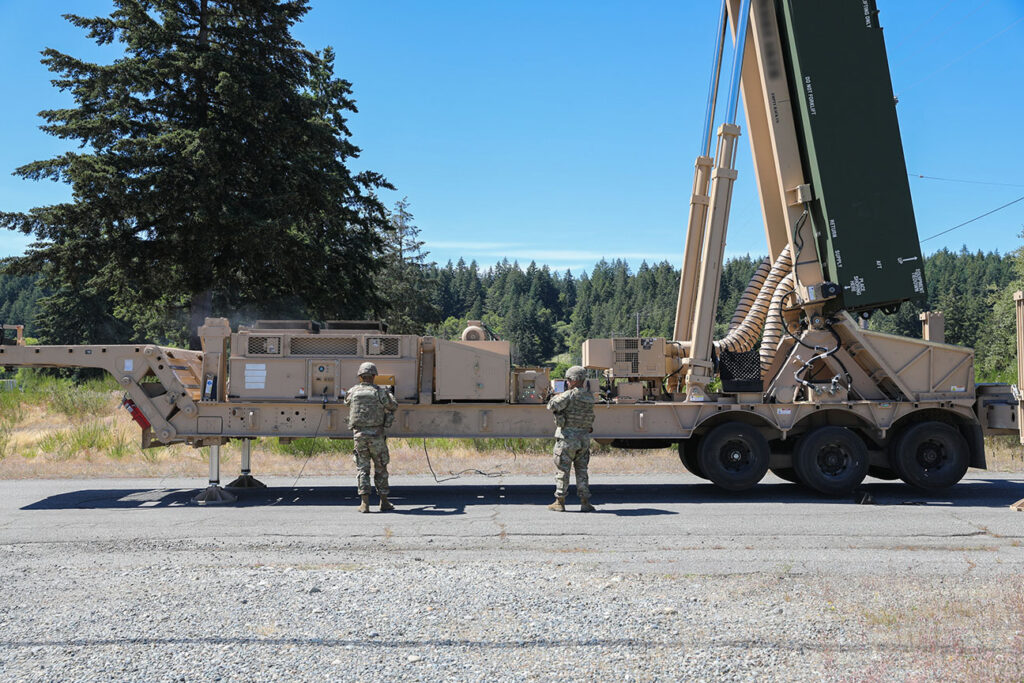Soldiers assigned to Bravo Battery, 5th Battalion, 3rd Field Artillery (Long Range Fires Battalion), 1st Multi-Domain Task Force, prepare one of the long-range hypersonic weapon transporter erector launchers to fire during exercise Resolute Hunter 24-2 on Joint Base Lewis-McChord, Washington, on June 25, 2024. CAPT. RYAN DEBOOY/U.S. ARMY
THE WATCH STAFF
The United States Army will deploy its “Dark Eagle” long-range hypersonic weapon (LRHW) with a combat unit by the end of its budget year in September, a defense official confirmed February 26 in a statement to Defense News magazine. The U.S. is racing to implement the missile system, as China, North Korea and Russia are actively developing and testing hypersonic weapons.
The Army successfully conducted an end-to-end flight test of Dark Eagle at the Pacific Missile Range Facility in Hawaii in May 2024. In June 2024, the LRHW Battery made history by participating in Exercise Resolute Hunter 24-2, a joint/combined exercise at Joint Base Lewis-McChord (JBLM). It was the first time the Army’s hypersonic capability was integrated into the biannual joint training exercise.
“The exercise demonstrated the battery’s ability to integrate with higher joint echelons and sustain operations over an extended period,” according to 1st Multi-Domain Task Force (1MDTF) at JBLM. “Bravo Battery, 5th Battalion, 3rd Field Artillery (Long Range Fires Battalion), 1MDTF, successfully employed its force package for over 72 hours, showcasing the LRHW digital kill chain in collaboration with joint partners and providing real-time situational awareness to the joint command post.”
The Army and Navy completed another successful test in December 2024 at Cape Canaveral Space Force Station, Florida, of the Common Hypersonic Glide Body (C-HGB), which is made up of the weapon’s warhead, guidance system, cabling and thermal protection shield.
“This test builds on several flight tests in which the Common Hypersonic Glide Body achieved hypersonic speed at target distances and demonstrates that we can put this capability in the hands of the warfighter,” then-Army Secretary Christine Wormuth said in a statement at the time.
The Army and Navy jointly developed the C-HGB. The Army will launch its version, the LRHW, from a mobile ground platform. The Navy’s version, Conventional Prompt Strike, will be launched from ships.
Hypersonic weapons can fly faster than Mach 5 — more than 6,173 kilometers per hour. Dark Eagle has a reported range of 2,776 kilometers and can maneuver between varying altitudes.
“They can reach the top of the Earth’s atmosphere and remain just beyond the range of air and missile defense systems until they are ready to strike, and by then it’s too late to react,” the Army says. “Extremely accurate, ultrafast, maneuverable and survivable, hypersonics can strike anywhere in the world within minutes.”
The Army has been working with Leidos Dynetics for years to build the industrial base for the C-HGB, marking the first time the private sector has manufactured such a system. Lockheed Martin is the weapons system integrator for the missiles, which will be launched from mobile trucks.

